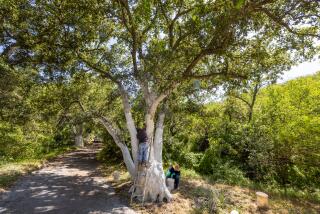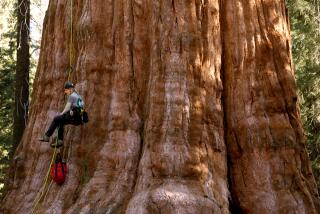Beech disease leaves a hole in Michigan’s northern forests
- Share via
seney national wildlife refuge, mich. -- Tracy Casselman runs a hand over the smooth, gray bark of an American beech, noting the scratch marks left by black bears that have clambered up the tree to munch nuts rich in fat and protein.
Perhaps 80 years old, a couple of feet in diameter and 60 feet high, the beech appears robust, like many of its neighbors scattered near a two-track road in the backcountry of Michigan’s Upper Peninsula. But appearances are deceiving. These trees likely are doomed.
“Take a good look,” says Casselman, manager of the Seney National Wildlife Refuge. “In five years, these trees won’t be here.”
Beech bark disease has taken hold in the refuge, a dagger aimed at the heart of a stalwart native hardwood. The American beech has relatively little economic value for people but plays a starring role in the natural drama acted out daily in Michigan’s northern forests.
Scientists expect the disease eventually will kill most of the state’s beeches, changing the environment in ways as yet uncertain. For example, it could affect populations of bears and smaller mammals that feed on beech nuts -- and that are favorite targets of hunters.
“Obviously there will be a shift in the ecology of the forest,” says Robert Heyd, forest health specialist with the Michigan Department of Natural Resources in Marquette.
The insect that causes beech bark disease has been overshadowed by the emerald ash borer, a voracious insect wreaking havoc on trees in southeastern Michigan and creeping northward.
Both have something in common with the zebra mussel, purple loosestrife, round goby and spiny water flea: They are foreign species introduced to the Great Lakes region through human carelessness, and are crowding out natives and profoundly altering the ecosystem.
“When I was in college, I could name maybe half a dozen exotics,” Casselman says. “Now I could spend 10 minutes rattling them off. I just wonder when people are going to recognize the cost of bringing all these exotics in.”
Federal studies say more than $120 billion is spent yearly in the United States controlling about 800 invasive species and repairing their damage. And the environmental losses -- extinction of native plants and animals, less biodiversity and natural beauty -- are incalculable.
Beech bark disease slipped into North America in 1890, courtesy of ornamental trees shipped from Europe to Nova Scotia. The disease was discovered in Michigan in 2000. It was first noticed in Ludington State Park on Lake Michigan and in Bass Lake State Forest Campground near McMillan in the Upper Peninsula, which suggests it could have arrived in firewood brought by campers from elsewhere.
Once established, beech bark disease can be spread by the wind, birds and animals that brush against infected trees.
“It can kill 75 to 80% of the [beech] trees in a given area,” says Michael Lusk, invasive species coordinator for the U.S. Fish and Wildlife Service. “Once it’s there, it’s everywhere. You’re done, you’re cooked.”
It begins with tiny scale insects that feed on sap in the tree’s thin bark. The scale injures the beeches, making them vulnerable to a fungus called nectria that kills tissue and entire trees.
“As far as trying to slow [the disease] or contain it, not much can be done,” McCullough says. DNR forest managers are thinning large beech stands in hopes of impeding its progress.
One hopeful sign: Some beech are proving resistant to the disease. Scientists are studying them in hopes of developing hardier strains that could be planted to rejuvenate the species, Heyd says.
Beeches are not the most prevalent of Michigan hardwoods, but their ecological value is considerable. Cavities in the older trees provide habitat for birds, fishers and pine martens. Hawks and eagles perch on their stout limbs. Triangle-shaped beech nuts are a crucial nutrient for many birds and mammals, including squirrels, deer, foxes, ducks, turkeys and blue jays.
“Bears are omnivores, so I don’t expect a big impact on them,” staff forester Greg Corace says. “But some species may be less adaptable. We just don’t know what will happen, but we suspect it isn’t going to be good.”
More to Read
Sign up for Essential California
The most important California stories and recommendations in your inbox every morning.
You may occasionally receive promotional content from the Los Angeles Times.












